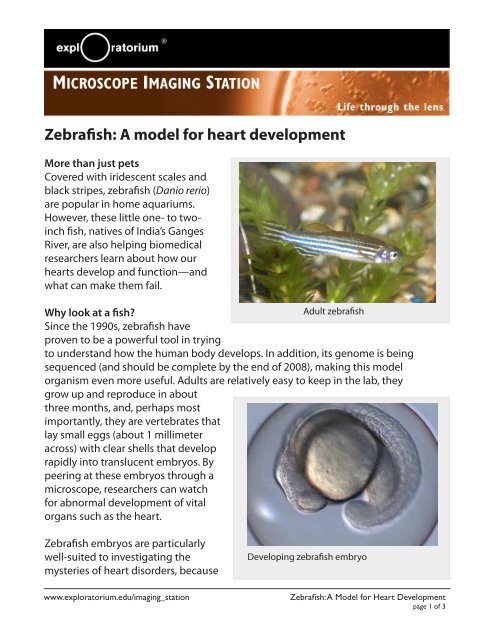Zebrafish: A model for heart development - Exploratorium
Zebrafish: A model for heart development - Exploratorium
Zebrafish: A model for heart development - Exploratorium
You also want an ePaper? Increase the reach of your titles
YUMPU automatically turns print PDFs into web optimized ePapers that Google loves.
<strong>Zebrafish</strong>: A <strong>model</strong> <strong>for</strong> <strong>heart</strong> <strong>development</strong><br />
More than just pets<br />
Covered with iridescent scales and<br />
black stripes, zebrafish (Danio rerio)<br />
are popular in home aquariums.<br />
However, these little one- to twoinch<br />
fish, natives of India’s Ganges<br />
River, are also helping biomedical<br />
researchers learn about how our<br />
<strong>heart</strong>s develop and function—and<br />
what can make them fail.<br />
Why look at a fish?<br />
Adult zebrafish<br />
Since the 1990s, zebrafish have<br />
proven to be a powerful tool in trying<br />
to understand how the human body develops. In addition, its genome is being<br />
sequenced (and should be complete by the end of 2008), making this <strong>model</strong><br />
organism even more useful. Adults are relatively easy to keep in the lab, they<br />
grow up and reproduce in about<br />
three months, and, perhaps most<br />
importantly, they are vertebrates that<br />
lay small eggs (about 1 millimeter<br />
across) with clear shells that develop<br />
rapidly into translucent embryos. By<br />
peering at these embryos through a<br />
microscope, researchers can watch<br />
<strong>for</strong> abnormal <strong>development</strong> of vital<br />
organs such as the <strong>heart</strong>.<br />
<strong>Zebrafish</strong> embryos are particularly<br />
well-suited to investigating the<br />
mysteries of <strong>heart</strong> disorders, because<br />
Developing zebrafish embryo<br />
www.exploratorium.edu/imaging_station <strong>Zebrafish</strong>: A Model <strong>for</strong> Heart Development<br />
page 1 of 3
even embryos that develop severely mal<strong>for</strong>med, nonbeating <strong>heart</strong>s can survive and<br />
continue to grow <strong>for</strong> several days. Because of the embryo’s small size, it does not need<br />
a working <strong>heart</strong>. As it turns out, the cells of this <strong>model</strong> organism do not depend on<br />
the circulation of blood <strong>for</strong> oxygen during its first few days of <strong>development</strong>: They can<br />
survive with the oxygen that diffuses in from the watery surroundings <strong>for</strong> the first<br />
week of life. Luckily, this is long enough <strong>for</strong> researchers to make crucial observations<br />
about how these defective <strong>heart</strong>s <strong>for</strong>m and malfunction over time.<br />
How is your <strong>heart</strong> like that of a zebrafish?<br />
Though distantly related, human and zebrafish <strong>heart</strong>s have much in common. Both<br />
are muscles designed to pump oxygen-carrying blood through the body. In both<br />
cases, the <strong>heart</strong> is made up of chambers with valves that ensure blood flows in the<br />
correct direction. And, in both cases, the <strong>heart</strong> pumps in a regular, rhythmic, way. The<br />
rhythmic beating of the <strong>heart</strong> in part depends on specialized <strong>heart</strong> muscle cells called<br />
myocytes that are normally a highly organized part of the <strong>heart</strong>’s structure.<br />
Human and zebrafish <strong>heart</strong>s<br />
Can a zebrafish help solve medical mysteries?<br />
Because zebrafish <strong>heart</strong>s are so similar to our own, scientists are using the fish to study<br />
many aspects of <strong>heart</strong> disease, particularly the role of genetic mutations that might<br />
cause <strong>heart</strong> abnormalities.<br />
One disease, called familial hypertrophic cardiomyopathy (HCM), is the leading cause of<br />
sudden death in young athletes. Researchers discovered that mutations in a gene that<br />
www.exploratorium.edu/imaging_station <strong>Zebrafish</strong>: A Model <strong>for</strong> Heart Development<br />
2 of 3
codes <strong>for</strong> a <strong>heart</strong> protein called troponin T are responsible <strong>for</strong> 15% of the cases of HCM.<br />
But until recently, how the mutation might cause the disease remained a mystery.<br />
Scientists had been studying a collection of zebrafish mutants that developed <strong>heart</strong><br />
abnormalities. The most severe of this collection was a defect named silent <strong>heart</strong>;<br />
embryos with this mutation had <strong>heart</strong>s that did not beat at all. Using molecular<br />
techniques, researchers found the gene that, when mutated, produces silent <strong>heart</strong><br />
also encodes the zebrafish version of the troponin T protein. In the case of silent <strong>heart</strong>,<br />
they found the gene so mutated that it failed to make any useful troponin T, and that<br />
this affected the production of two other important <strong>heart</strong> proteins. The failure of this<br />
system of proteins created disorganized <strong>heart</strong> muscle cells (myocytes) that in turn<br />
failed to organize into a <strong>heart</strong> effective at circulating blood. In humans with HCM,<br />
myocytes are also disorganized, which can lead to an abnormal <strong>heart</strong>beat, and in some<br />
cases, sudden death.<br />
By examining the effects of the silent <strong>heart</strong> mutation in zebrafish, more light can<br />
be shed on how mutations in the human troponin T could result in HCM in humans.<br />
Researchers hope to find still more parallels between zebrafish <strong>heart</strong> mutants and<br />
<strong>heart</strong> disease in humans. Understanding the genetics and biology behind <strong>heart</strong><br />
<strong>for</strong>mation and function will help scientists design therapies and interventions in the<br />
future to help keep <strong>heart</strong>s healthy.<br />
www.exploratorium.edu/imaging_station <strong>Zebrafish</strong>: A Model <strong>for</strong> Heart Development<br />
3 of 3
















